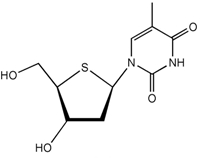Here we describe the usage of the MATLAB GUI for the conformational analysis of a 4'-thio-2'-deoxynucleoside based on literature information (Koole et al., J Am Chem Soc 1992, 114(25):9936-9943). For this molecule, five scalar coupling constants were measured for five different temperatures.
Step 1. Molecular orientation
First, one should choose an orientation of the five-membered ring. In this example we have chosen the orientation of the molecule as shown below, the sulfur atom being on top and C1' (i.e. the carbon atom to which the nucleic base is attached) at the right. Using this orientation, the endocyclic torsion angles are numbered as follows: v0 (C2'-C3'), v1 (C3'-C4'), v2 (C4'-S), v3 (S-C1') and v4 (C1'-C2').

Step 2. Defining Couplings
Now that we have defined the orentation of the molecule, we can start to introduce all the experimental data into the MATLAB GUI. In the first step, the scalar couplings that have been measured, need to be defined. The picture below shows the steps needed to define the coupling between H1' and H2". First select the two checkboxes corresponding to the coupled hydrogen atoms. Second, click the 'Add' button. This will add the coupling to the listbox.

Repeat this procedure for the remaining four scalar coupling constants that can be measured for this thiodeoxyribose moeity. The result should be as shown below:

Step 3. Adding Coupling Constants
Step 4. Refining Parameters
Step 5. Defining Electronegativities
Step 6. Searching the best fit
Step 6'. Exploring the whole pseudorotation phase